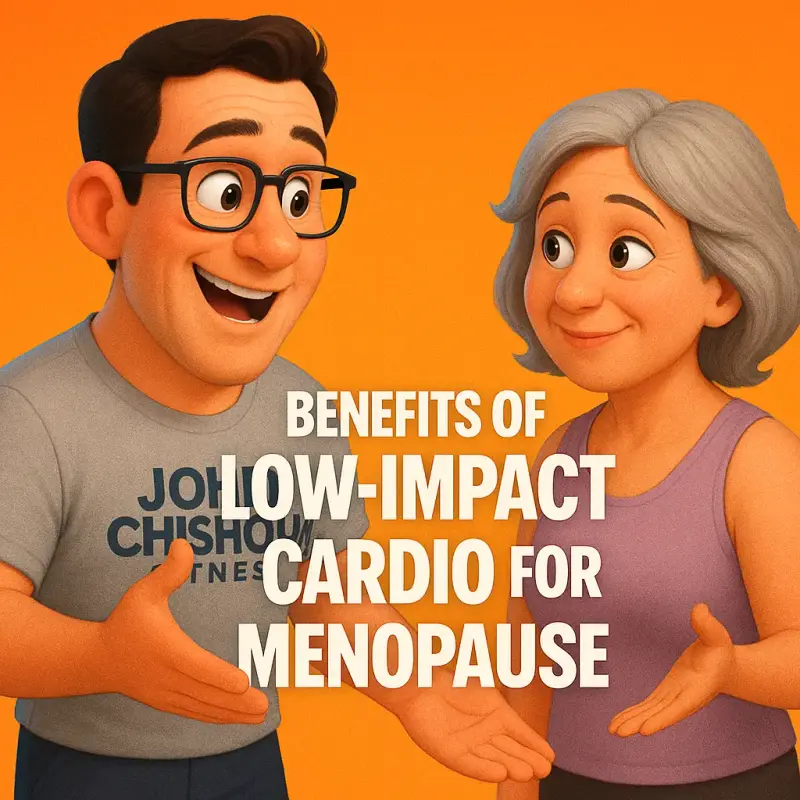Low-Impact Cardio for Menopause Fatigue & Joint Pain Relief
Why Cardio Matters During Menopause
Menopause causes many changes, like hormone shifts, joint pain, fatigue, and a slower metabolism.
The good news? Cardio can help.
Some believe it may not be beneficial, but that’s not true.
Here’s why cardio matters during menopause (Why Hire a Menopause Fitness Coach?):
#1 Heart Health Benefits:
Cardio strengthens the heart, improves circulation, and reduces the risk of heart disease.
This is vital since heart disease is the leading cause of death among women.
Regular cardio helps slow the decline in vascular health during menopause.
Research shows that aerobic walking can improve heart health in postmenopausal women.
One study found it increased HDL cholesterol (the good type cholesterol) by 29.96% and reduced LDL cholesterol (the bad type of cholesterol) by 27.01% (Lin & Lee, 2018).
This matters because heart disease is the top cause of death for women.
So, it's super important to do regular cardio as it helps keep blood vessels healthy during menopause.
#2 Hormonal Balance:
Many think cardio negatively affects hormones, but it can actually help regulate them.
While too much high-intensity interval training (HiiT) can increase cortisol (a major stress hormone), moderate cardio and structured HiiT can be beneficial.
Research shows that moderate aerobic exercise helps balance hormones (Exercise Tips for Menopause).
It improves cholesterol levels and supports blood vessel function.
(For clarity, moderate intensity exercise, cardio speaking, is around 55% of your max. heart rate, or 5/6 on a 1 - 10 scale.
So, as an example, when you are walking briskly, your breathing should be slightly elevated. That is normal, and with that degree of elevated breathing, you'll be walking at a moderate intensity!
However, If you cant maintain a conversation, then your likely going too fast, if thats the case, it becomes intensive, not moderate!
#3 Weight Management:
Weight gain is common in menopause.
Cardio, including walking, helps manage it (Menopause Weight Loss Myths & Truths).
However, when you combine that walk with some strength training. Magical things will start to happen....
...strength training preserves muscle mass and bone density, both are crucial at this stage.
Research shows that aerobic and resistance training improve fitness and muscle strength (Khalafi et al, 2023).
This helps manage weight gain in postmenopausal women.
Strength training also preserves muscle and bone health, which is important at this stage (Khalafi et al, 2023).
#4 Mental Health:
Menopause can bring stress, anxiety, and depression.
Cardio releases endorphins, which boost mood and reduce stress.
Exercise helps lower inflammation and supports the immune system (Khalafi et al, 2023).
This improves mental health. Cardio also releases endorphins, which boost mood and ease stress.
High-intensity workouts may be too much, but low-impact cardio is a great way to stay active (Best Menopause Workouts to Burn Fat & Boost Energy).
It supports heart health, eases menopause symptoms, and is gentle on the joints.
Ok, science lesson over, lets dive into the good stuff...

Benefits of Low-Impact Cardio for Menopause
- ✅ Boosts daily energy without exhausting your body
- ✅ Protects joint health with reduced impact movement
- ✅ Improves mood & focus by lowering stress hormones
- ✅ Encourages consistency with easier, sustainable options
- ✅ Supports weight balance without high cortisol workouts

Best Types of Low-Impact Cardio for Menopause
- 🚶 Walking: Gentle on joints, easy to stick with, and perfect for boosting energy and mood. Aim for 20–30 mins daily.
- 🚴♀️ Cycling: Whether outdoor or stationary, it’s a great way to support cardiovascular health without pounding your knees.
- 🏊 Swimming or Water Aerobics: The buoyancy of water reduces joint stress while offering full-body movement and strength.
- 🧘♀️ Rebounding (Mini Trampoline): A fun and surprisingly gentle option that supports lymphatic health and coordination.
- 🧍♀️ Dance-Based Cardio: Low-impact dance or movement classes keep things fun while improving rhythm, agility, and heart health.
Try the Power 7 Blast™ Today
Short on time or energy? The Power 7 Blast™ is a quick, joint-friendly workout designed for menopause, just 7 moves, no stress, and all the benefits.

Let’s Personalise Your Plan: Exercise Readiness Form
Before jumping into any workout, it's vital to understand how your body is feeling — especially in midlife. This quick self-check will help you move with confidence, avoid burnout, and tune into what your body truly needs today.
A Simple 30-Minute Low-Impact Cardio Routine
This feel-good workout is designed for midlife women looking to lift energy, improve circulation, and feel recharged. It’s low-impact, easy to follow, and perfect if you’re returning to movement or dealing with fatigue during menopause.
| 🔥 Warm-Up (5 Minutes) | |
|---|---|
| 🧍 March in Place | 1 minute |
| ↔️ Side Steps + Arm Swings | 2 minutes |
| 🌀 Light Squats + Hip Circles | 2 minutes |
| 💪 Main Workout (20 Minutes) | |
| 🚶♀️ Brisk Walk or March in Place | 5 minutes |
| 🚴♀️ Elliptical or Cycling | 5 minutes |
| 💃 Dance or Low-Impact Aerobics | 5 minutes |
| ⏫ Rebounding or Step Touches | 5 minutes |
| 🧘♀️ Cool-Down (5 Minutes) | |
| 🦵 Stretch: Hamstrings, Hips, Shoulders | — |
| 🌬️ Deep Breathing | — |
Check out www.johnchisholmfitness.health for more energy-boosting workouts and wellness tips.
Keep exploring 👇
Discover more tips to feel stronger, more energised, and in control of your health:
How to Maximise Your Results
How Often? Aim for around 150 minutes of low-impact cardio per week (ie., 30 minutes, five days a week).
Add Strength & Flexibility – Include strength training 2-3 times a week and yoga or Pilates.
Track Progress – Focus on energy, sleep, and mood, not just weight.
Listen to Your Body – Adjust exercises based on how you feel.
Final Thoughts: Small Changes, Big Results
🌟 Ready to Recharge Your Energy?
Join others who’ve already started transforming their energy, sleep, and confidence with our FREE 7-Day Menopause Energy Reset.
👉 Download the FREE Reset Guide NowFrequently Asked Questions
Is low-impact cardio enough to boost my energy during menopause?
Yes — consistent low-impact cardio can support hormone balance, circulation, and reduce fatigue. It’s especially effective when combined with strength training and proper rest.
What are the best low-impact exercises if I have joint pain?
Gentle walking, cycling, swimming, and rebounding are excellent choices. They reduce pressure on your joints while still boosting heart rate, circulation, and mood.
How often should I do low-impact cardio during menopause?
Most midlife women benefit from 3–5 sessions per week, around 20–30 minutes each. Start slow and build up as your energy and mobility improve.
Will I lose weight doing low-impact workouts?
Weight loss depends on many factors including hormones, sleep, and diet. Low-impact cardio supports fat loss, but strength training and nutrition are key too.
Can I combine low-impact cardio with strength training?
Absolutely. In fact, combining both is one of the most effective approaches during menopause to support metabolism, bone health, and overall energy.
You Might Also Like: More Menopause & Fitness Insights
Looking for more expert-backed guidance on menopause and exercise? Check out these helpful posts:


